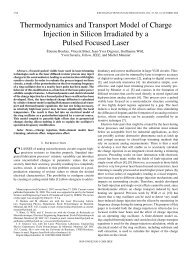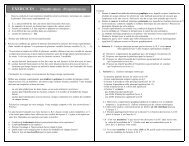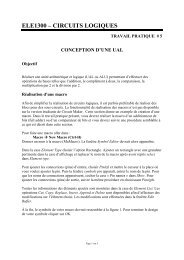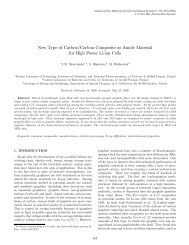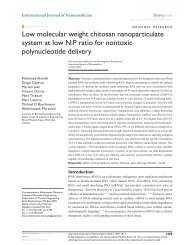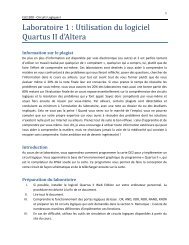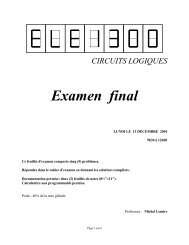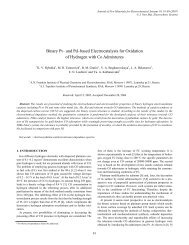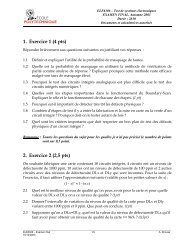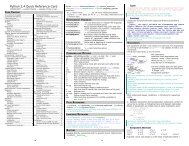Monolithic gelation of chitosan solutions via enzymatic hydrolysis of ...
Monolithic gelation of chitosan solutions via enzymatic hydrolysis of ...
Monolithic gelation of chitosan solutions via enzymatic hydrolysis of ...
You also want an ePaper? Increase the reach of your titles
YUMPU automatically turns print PDFs into web optimized ePapers that Google loves.
<strong>Monolithic</strong> <strong>gelation</strong> <strong>of</strong> <strong>chitosan</strong> <strong>solutions</strong> <strong>via</strong> <strong>enzymatic</strong> <strong>hydrolysis</strong> <strong>of</strong> urea<br />
Abstract<br />
A. Chenite a, *, S. Gori b , M. Shive a , E. Desrosiers a , M.D. Buschmann b<br />
a Department <strong>of</strong> Chemistry, Biosyntech Inc., 475 Blvd Armand-Frappier, Laval, Que., Canada H7V 4B3<br />
b Department <strong>of</strong> Chemical Engineering, Institute <strong>of</strong> Biomedical Engineering, Ecole Polytechnique, Montreal, Que., Canada H3C 3J7<br />
Received 22 June 2005; received in revised form 8 December 2005; accepted 10 December 2005<br />
Available online 20 January 2006<br />
A novel process for the formation <strong>of</strong> physical hydrogels <strong>of</strong> <strong>chitosan</strong> from injectable aqueous <strong>solutions</strong> is investigated. Uniform neutralization <strong>of</strong><br />
<strong>chitosan</strong> <strong>solutions</strong> with ammonia generated in situ from <strong>enzymatic</strong> <strong>hydrolysis</strong> <strong>of</strong> urea is shown to produce pH-induced hydrogels with monolithic<br />
and homogeneous coherent 3D structure. Hydrogel formation was characterized by rheology. We found that the <strong>gelation</strong> time decreases as<br />
temperature increases from 15 to 45 8C as a consequence <strong>of</strong> synergistic effect <strong>of</strong> increased reactant diffusion and increased urease activity<br />
(maximum activity at 37 8C). The effects <strong>of</strong> urea and urease concentration are also presented.<br />
q 2006 Elsevier Ltd. All rights reserved.<br />
Keywords: Chitosan; <strong>Monolithic</strong> hydrogel; Rheology; pH-induced <strong>gelation</strong>; Sol–gel transition<br />
1. Introduction<br />
The gelled state <strong>of</strong> biopolymers enhances their biotechnological<br />
usefulness as biocompatible and biodegradable biomaterials.<br />
Polysaccharides represent a significant portion <strong>of</strong><br />
natural biopolymers and are <strong>of</strong> particular interest for forming<br />
stable hydrated gels or hydrogels as evidenced by their use in a<br />
myriad <strong>of</strong> industrial applications in the food, cosmetics,<br />
pharmaceutical and biomedical industries (Einerson et al.,<br />
2003; Peppas, 1985; Rathna & Chatterji, 1996). Many<br />
polysaccharide aqueous <strong>solutions</strong> are environmentally<br />
sensitive as they can be physically cross-linked into hydrated<br />
gels in response to environmental changes such as temperature,<br />
pH or solvent. The scope <strong>of</strong> interest is usually restricted to<br />
aqueous <strong>solutions</strong>, since the aqueous environment is <strong>of</strong>ten<br />
essential to meet cytocompatibility and biological activity<br />
requirements in vivo.<br />
It is well known that the <strong>solutions</strong> <strong>of</strong> many biopolymers<br />
which dissolve in hot water, such as agarose (Nishinari et al.,<br />
1992), gelatin (Higgs & Ross-Murphy, 1990) and carrageenan<br />
(Nishinari & Watase, 1992; Richardson & Goycoolea, 1994),<br />
can form reversible gels if cooled down below a critical<br />
<strong>gelation</strong> temperature. Conversely, other biopolymers, which<br />
form aqueous <strong>solutions</strong> at cold temperature, such as<br />
* Corresponding author. Tel.: C1 514 686 2437x235; fax: C1 514 686 8952.<br />
E-mail address: chenite@biosyntech.com (A. Chenite).<br />
0144-8617/$ - see front matter q 2006 Elsevier Ltd. All rights reserved.<br />
doi:10.1016/j.carbpol.2005.12.010<br />
Carbohydrate Polymers 64 (2006) 419–424<br />
www.elsevier.com/locate/carbpol<br />
methylcellulose (Haque & Morris, 1992; Nishinari, 1997)<br />
and hydroxypropyl cellulose (Guenet, 1992) can form<br />
reversible gels upon heating. Similarly, biopolymers that<br />
dissolve in water in a particular pH range may gel upon<br />
subsequently changing the pH. Since pH-induced <strong>gelation</strong><br />
takes place instantly and locally upon the addition <strong>of</strong> the acid or<br />
the base, the resulting gel is non-uniformly hydrated and is<br />
essentially formed <strong>of</strong> aggregated or precipitated gelled<br />
particulates. In contrast, since the heating and cooling<br />
processes can be more spatially uniform than diffusion <strong>of</strong><br />
acid or base, thermosensitive <strong>solutions</strong> can <strong>of</strong>ten provide<br />
greater structural homogeneity <strong>of</strong> resulting gels, and permits<br />
them to be shaped into desired forms.<br />
Chitosan is a polysaccharide that requires specific pH<br />
conditions to be water-soluble. Its unique cationic characteristics<br />
and the gel- and film-forming properties (Chandy &<br />
Sharma, 1990; Felt, Buri, & Gurny, 1998; Illum, 1998) have<br />
attracted considerable attention. Chitosan is obtained by<br />
alkaline deacetylation <strong>of</strong> chitin, a cellulose-like polysaccharide<br />
that is extracted from the shells <strong>of</strong> crustaceans such as crabs,<br />
shrimps and lobsters (Muzzarelli, 1973). While chitin is<br />
completely insoluble in aqueous media, <strong>chitosan</strong> can be<br />
dissolved under acidic conditions that provide sufficient<br />
protonation <strong>of</strong> its amino groups. The resulting aqueous<br />
<strong>solutions</strong> are usually stable as long as the pH is below 6.2.<br />
Neutralisation <strong>of</strong> <strong>chitosan</strong> <strong>solutions</strong> by common alkali<br />
<strong>solutions</strong> then leads systematically to the formation <strong>of</strong><br />
a hydrated gel-like precipitate when the pH exceeds<br />
approximately 6.2.
420<br />
Physical hydrogels <strong>of</strong> <strong>chitosan</strong> have been induced through<br />
complex formation with multivalent anions (Draguet, Va˚rum,<br />
Moen, Gynnild, & Smidsr:d, 1992; Hirano, Yamaguchi,<br />
Fukui, & Iwata, 1990) and anionic polyelectrolytes (Fukuda &<br />
Kikuchi, 1979; Sakiyama, Takata, Kikuchi, & Nakanishi,<br />
1999; Takahashi, Takayama, Machida, & Nagai, 1990) as well<br />
as by simply increasing pH above the pK a (Cairns et al., 1992;<br />
Montembeault, Viton, & Domard, 2005; Rodriguez-Sanchez &<br />
Rha, 1981) or by increasing the temperature in the presence <strong>of</strong><br />
a polyol buffer (Chenite, Buschmann, Wang, Chaput &<br />
Kandani, 2001; Chenite et al., 2000).<br />
Current processes for forming <strong>chitosan</strong> gels <strong>via</strong> pH<br />
sensitivity (Cairns et al., 1992; Montembeault, Viton, &<br />
Domard, 2005; Rodriguez-Sanchez & Rha, 1981) include (i)<br />
neutralizing an acidic solution <strong>of</strong> <strong>chitosan</strong> with alkaline<br />
<strong>solutions</strong> (NaOH, KOH or NH4OH), (ii) treating <strong>chitosan</strong><br />
<strong>solutions</strong> with gaseous NH3 or (iii) dialyzing <strong>chitosan</strong> against<br />
alkaline media. However, due to the sluggishness <strong>of</strong> diffusionmediated<br />
processes, these three approaches fail to produce a<br />
structurally homogeneous <strong>chitosan</strong> hydrogels due to pH<br />
gradients present at the time <strong>of</strong> gel formation. In contrast, a<br />
procedure that could homogeneously modulate pH and<br />
minimize gradients <strong>of</strong> pH at the time <strong>of</strong> gel formation could<br />
provide a monolithic and homogeneous hydrogel structure with<br />
superior biotechnological performance.<br />
We report here the formation <strong>of</strong> monolithic <strong>chitosan</strong><br />
hydrogels <strong>via</strong> the neutralization <strong>of</strong> <strong>chitosan</strong> <strong>solutions</strong> through<br />
gradual in situ generation <strong>of</strong> base from an alkaline source that<br />
is uniformly incorporated and dissolved within the polymeric<br />
<strong>solutions</strong>. This source <strong>of</strong> base is the <strong>hydrolysis</strong> <strong>of</strong> urea, a<br />
reaction catalyzed by the introduction <strong>of</strong> a specific enzyme,<br />
urease. Resulting gels have been investigated by performing<br />
rheological measurements.<br />
2. Experimental section<br />
2.1. Materials<br />
Chitosan with medium viscosity and a degree <strong>of</strong> deacetylation,<br />
DDA, <strong>of</strong> 88% was produced in house. The raw material,<br />
<strong>chitosan</strong> with high molecular weight and DDA <strong>of</strong> 80% from<br />
Marinard Ltd was further deacetylated and purified at<br />
Biosyntech. This finished <strong>chitosan</strong> was fully characterized<br />
and certified as an ultra pure <strong>chitosan</strong> for medical and<br />
pharmaceutical use. The final average molecular weight <strong>of</strong><br />
3.5!10 5 and the DDA <strong>of</strong> 88% were determined by size<br />
exclusion chromatography (SEC) (Brugnerotto, Desbrières,<br />
Roberts, & Rinaudo, 2001) and 1 H NMR (Lavertu, Xia, &<br />
Serreqi, 2003) spectroscopy, respectively.<br />
Urea, Urease and HCl (0.1 M) were purchased from Sigma.<br />
Urease activity established by the supplier was 66.3 u/mg.<br />
2.2. Preparation <strong>of</strong> <strong>solutions</strong><br />
Chitosan <strong>solutions</strong> (2.25% w/v) were prepared by dissolving<br />
200.0 mg <strong>of</strong> <strong>chitosan</strong> in 8.9 mL <strong>of</strong> 0.1 M HCl at room<br />
temperature with a resulting pH <strong>of</strong> 5.3. This clear solution<br />
A. Chenite et al. / Carbohydrate Polymers 64 (2006) 419–424<br />
was supplemented with 0.1 mL <strong>of</strong> urease solution (1 mg/mL)<br />
and then cooled down to w4 8C, in order to inhibit urease<br />
<strong>enzymatic</strong> activity. This cooled solution was then supplemented<br />
with 1.0 mL <strong>of</strong> urea solution (0.5 M) under vigorous<br />
stirring. The stirring was maintained for an additional 30 min,<br />
after which the mixture was poured into a rheometer cell for the<br />
rheological measurements. The composition <strong>of</strong> the final<br />
solution was then 2% w/v <strong>of</strong> <strong>chitosan</strong> with 43 mM urea and<br />
17.2 mg/mL urease.<br />
The effects <strong>of</strong> urea and urease were further investigated by<br />
varying concentrations between 23.4 and 71.4 mM for urea,<br />
and from 9 to 67.8 mg/mL for urease, while maintaining a<br />
constant <strong>chitosan</strong> concentration.<br />
2.3. Rheological measurements<br />
Viscoelastic properties were measured with a CVO<br />
rheometer (Bohlin Instrument Inc. Crandbury, NJ) equipped<br />
with SSC25 concentric cylinders. The solution sample volume<br />
was 3 mL <strong>of</strong> solution, which were covered with mineral oil to<br />
prevent evaporation during measurements.<br />
The time evolution <strong>of</strong> elastic and viscous moduli, G 0 and G 00 ,<br />
were measured at constant temperature within the linear<br />
viscoelastic region at a fixed frequency <strong>of</strong> 1 Hz. The <strong>gelation</strong><br />
time (t g) was taken as the time at which G 0 ZG 00 , following the<br />
approach proposed by Winter and Chambon (Chambon &<br />
Winter, 1987; Winter & Chambon, 1986). The frequency<br />
dependence <strong>of</strong> G 0 and G 00 <strong>of</strong> <strong>solutions</strong> and gels was also<br />
characterized in the frequency range 0.01–10 Hz, after<br />
equilibrating samples at 37 8C for about 30 min.<br />
3. Results and Discussion<br />
It is well known that <strong>chitosan</strong> hydrogels can be obtained by<br />
simply adding alkali to raise the pH <strong>of</strong> <strong>chitosan</strong> <strong>solutions</strong>.<br />
However, the resulting gels lack cohesion since they consist <strong>of</strong><br />
aggregated particulate gels, for example when treated with a<br />
basic solution (Onsoyen & Skaugurd, 1991). These diffusioncontrolled<br />
processes have been shown to result in local<br />
precipitation when dialyzed against sodium hydroxide solution<br />
for 24 h (Cairns et al., 1992; Rodriguez-Sanchez & Rha, 1981)<br />
or to form a layer <strong>of</strong> gel that gradually expands from the surface<br />
<strong>of</strong> the sample towards the bottom when exposed to gaseous<br />
ammonia (Montembeault, Viton, & Domard, 2005).<br />
The purpose <strong>of</strong> the present study was to investigate whether<br />
a more uniform neutralization <strong>of</strong> a <strong>chitosan</strong> solution leads to<br />
the preparation <strong>of</strong> a monolithic and homogeneous gel <strong>of</strong><br />
<strong>chitosan</strong> with greater cohesive structure. Such neutralization<br />
may be possible if an alkaline source is dissolved and<br />
uniformly distributed at molecular level within the <strong>chitosan</strong><br />
solution. Urea, a neutral substance whose <strong>hydrolysis</strong> generates<br />
ammonia is the example <strong>of</strong> alkaline source used in the current<br />
study. The <strong>hydrolysis</strong> reaction is depicted in Fig. 1. However,<br />
as this <strong>hydrolysis</strong> is extremely slow under normal conditions, it<br />
is necessary to use urease, a well-known <strong>enzymatic</strong> catalyst <strong>of</strong><br />
urea <strong>hydrolysis</strong>. The accompanying acidification <strong>of</strong>
Fig. 1. Illustration <strong>of</strong> urea <strong>hydrolysis</strong> in presence <strong>of</strong> urease.<br />
the solution due to CO2 formed during the <strong>hydrolysis</strong> reaction<br />
is expected to be negligible.<br />
We found that an initially transparent <strong>chitosan</strong> solution<br />
containing urease that is admixed with urea became progressively<br />
more turbid and more viscous (data not shown), leading<br />
to the formation <strong>of</strong> a very dense and opaque gel. The increase<br />
<strong>of</strong> both turbidity and viscosity was a consequence <strong>of</strong> increasing<br />
pH from a progressive release <strong>of</strong> NH4OH molecules upon the<br />
<strong>enzymatic</strong> <strong>hydrolysis</strong> <strong>of</strong> urea. This clearly suggests the<br />
formation <strong>of</strong> pH-induced monolithic hydrogel <strong>of</strong> <strong>chitosan</strong><br />
with a truly homogeneous 3D structure.<br />
3.1. Rheological characterization<br />
Progressive <strong>gelation</strong> <strong>of</strong> <strong>chitosan</strong> <strong>solutions</strong> (2% w/v),<br />
admixed with urea (43 mM) and urease (17.2 mg/mL) was<br />
evidenced by rheologically assessing the time evolution <strong>of</strong> G 0<br />
(elastic modulus) and G 00 (viscous modulus) at 37 8C (Fig. 2).<br />
Initially, during the first 15 min, G 0 is inferior to G 00 indicating<br />
that the released NH4OH has increased the pH from 5.3 to near<br />
6.2 where <strong>chitosan</strong> is still soluble. Subsequently, continued<br />
NH4OH release increases pH above 6.2, thus entering a domain<br />
where <strong>chitosan</strong> tends to precipitate or gel. A sudden increase <strong>of</strong><br />
the elastic modulus is then observed, that slows down to<br />
eventually reach a plateau. This dramatic increase <strong>of</strong> G 0 is<br />
attributed to the initial fast rate <strong>of</strong> network formation,<br />
facilitated by the high concentration <strong>of</strong> reactants including<br />
<strong>chitosan</strong>. The following decrease in the rate <strong>of</strong> change <strong>of</strong> G 0<br />
finally approaches completion due to depletion <strong>of</strong> reactants,<br />
as confirmed previously (Gori, 2002). The kinetics <strong>of</strong><br />
Fig. 2. Time evolution <strong>of</strong> G 0 and G 00 at 37 8C for <strong>chitosan</strong>/urea solution in<br />
presence <strong>of</strong> urease.<br />
A. Chenite et al. / Carbohydrate Polymers 64 (2006) 419–424 421<br />
the <strong>gelation</strong> process can be characterized as first order using<br />
the Eq. (Nishinari, 1997)<br />
G 0 ðtÞ Z G satð1KexpKkðtKt 0Þ<br />
where t0 is a latency time, k is a rate constant and Gsat is the<br />
saturated value <strong>of</strong> the storage modulus after long times. Closer<br />
inspection <strong>of</strong> Fig. 2 (not shown here) also shows the viscous<br />
modulus slightly increasing with time and then stabilizing. This<br />
observation is attributed to the formation <strong>of</strong> initial <strong>chitosan</strong><br />
clusters, which render the solution more viscous than<br />
individual molecules. Very quickly, these clusters form<br />
networks, thereby producing a more significant increase <strong>of</strong><br />
elastic modulus (G 0 ).<br />
Fig. 3(a) compares the rheological behaviors <strong>of</strong> <strong>chitosan</strong><br />
<strong>solutions</strong> containing urea in presence versus the absence <strong>of</strong><br />
urease. The complex viscosity (h * ) <strong>of</strong> <strong>chitosan</strong>/urea solution in<br />
the absence <strong>of</strong> urease is nearly frequency-independent,<br />
indicating Newtonian behavior, while the complex viscosity<br />
obtained in the presence <strong>of</strong> urease is much higher and decreases<br />
as the frequency increases, revealing a thixotropic behavior.<br />
The latter suggests the presence <strong>of</strong> associative polymer<br />
network that break down as the frequency dependent shear<br />
forces increase.<br />
The frequency dependence <strong>of</strong> both G 0 and G 00 has also been<br />
investigated for <strong>chitosan</strong>/urea <strong>solutions</strong> incubated at 37 8C for<br />
about 30 min both with and without addition <strong>of</strong> urease<br />
providing additional clear evidence <strong>of</strong> the difference in<br />
Fig. 3. Frequency-dependence <strong>of</strong> (a) complex viscosity and (b) elastic (G 0 ) and<br />
viscous (G 00 ) moduli for <strong>chitosan</strong>/urea <strong>solutions</strong> incubated at 37 8C for 30 min<br />
with and without urease.
422<br />
rheological behavior between these <strong>solutions</strong> (Fig. 3(b)). In the<br />
absence <strong>of</strong> urease, G 0 is below G 00 at low frequencies and both<br />
moduli increase with the frequency. The increase <strong>of</strong> G 0 is<br />
greater so that it exceeds G 00 at higher frequencies, as is<br />
characteristic <strong>of</strong> semi-diluted polymer solution. On the other<br />
hand, in the presence <strong>of</strong> urease, G 0 is much higher than G 00 over<br />
the entire frequency range, and both moduli are essentially<br />
frequency independent, a behavior that is typical <strong>of</strong> hydrogels<br />
(Delben, Lapasin, & Pricl, 1990; Nishinari, 1997) and quite<br />
similar to that reported for <strong>chitosan</strong>/glycerophosphate thermosensitive<br />
hydrogels (Chenite, Buschmann, Wang, Chaput, &<br />
Kandani, 2001).<br />
The effects <strong>of</strong> key parameters such as temperature, urea and<br />
urease concentrations on the auto-<strong>gelation</strong> <strong>of</strong> <strong>chitosan</strong>/urea<br />
<strong>solutions</strong> were investigated <strong>via</strong> their influence on the <strong>gelation</strong><br />
time (tg).<br />
3.1.1. Influence <strong>of</strong> Temperature<br />
Fig. 4(a) shows an exponential decrease <strong>of</strong> <strong>gelation</strong> time (tg)<br />
when temperature increases from 15 to 45 8C. The acceleration<br />
<strong>of</strong> the network formation could be attributed to the<br />
enhancement <strong>of</strong> the diffusion <strong>of</strong> reactants (urea, urease and<br />
<strong>chitosan</strong>) and their interactions with the increase <strong>of</strong> the<br />
temperature as well as the attainment <strong>of</strong> maximum<br />
Fig. 4. Variation <strong>of</strong> <strong>gelation</strong> time (tg) as function <strong>of</strong> temperature: (a)<br />
exponential decrease <strong>of</strong> tg with the temperature, and (b) linear relationship <strong>of</strong><br />
ln(t g) versus 1/T.<br />
A. Chenite et al. / Carbohydrate Polymers 64 (2006) 419–424<br />
Fig. 5. Gelation time (tg) versus urease concentration for <strong>chitosan</strong>/urea solution.<br />
Chitosan 2% w/v and urea (43 mM).<br />
activity <strong>of</strong> urease at 37 8C. The linear relationship between<br />
ln(tg) and 1/T(K), depicted in Fig. 4(b), suggests that<br />
the temperature-dependence <strong>of</strong> the <strong>gelation</strong> can be represented<br />
by the Arrhenius equation<br />
lnðtgÞ Z A C Ea<br />
RT<br />
where A is a constant, R the ideal gas constant, and T the<br />
temperature. Using this equation, an activation energy, Ea, <strong>of</strong><br />
59.8 kJ/mol, was calculated and is similar to the values <strong>of</strong> 68<br />
and 57 kJ/mol, calculated for the <strong>gelation</strong> <strong>of</strong> <strong>chitosan</strong> induced<br />
by N-acetylation and N-hexanoylation respectively (Moore &<br />
Roberts, 1980).<br />
3.1.2. Influence <strong>of</strong> urease concentration<br />
Gelation was also accelerated by increasing urease<br />
concentration (Fig. 5). A urease concentration <strong>of</strong> 40 mg/mL<br />
and higher produces essentially instantaneous <strong>gelation</strong> at 37 8C<br />
under the given experimental conditions.<br />
3.1.3. Influence <strong>of</strong> urea concentration<br />
Gelation time (tg) also depended on the urea concentration<br />
(Fig. 6). However, the significant acceleration <strong>of</strong> the <strong>gelation</strong><br />
Fig. 6. Dependence <strong>of</strong> <strong>gelation</strong> time (tg) as function <strong>of</strong> urea concentration for<br />
<strong>chitosan</strong> solution (2% w/v) in presence <strong>of</strong> urease (17.2 mg/mL).
observed when urea concentration was increased up to 60 mM,<br />
was followed by a slowing down <strong>of</strong> <strong>gelation</strong> at higher urea<br />
concentrations. This latter slowing down <strong>of</strong> <strong>gelation</strong> can be<br />
attributed to inhibition due to high substrate concentrations or<br />
to the ability <strong>of</strong> urea to reduce attractive interchain hydrogen<br />
bonding and hydrophobic forces, or possibly to a combination<br />
<strong>of</strong> both factors. However, the minimum urea concentration<br />
(36 mM in Fig. 6) to obtain <strong>gelation</strong> corresponds to a urea<br />
concentration that brings the pH <strong>of</strong> the <strong>chitosan</strong> solution just<br />
above 6.2 after 30 min <strong>of</strong> urea <strong>hydrolysis</strong> at 37 8C. This pH also<br />
corresponds approximately to the apparent pKa <strong>of</strong> <strong>chitosan</strong><br />
amino groups that is also known to be the limit above which<br />
block acetylated <strong>chitosan</strong> cannot be maintained in a solution<br />
state.<br />
4. Conclusion<br />
The present study demonstrates that pH-induced monolithic<br />
hydrogels can be produced <strong>via</strong> uniform neutralization <strong>of</strong><br />
slightly acidic <strong>chitosan</strong> <strong>solutions</strong> with ammonia generated from<br />
<strong>enzymatic</strong> <strong>hydrolysis</strong> <strong>of</strong> urea. The resulting gels have a<br />
homogeneous 3D coherent structure. Rheology was used to<br />
characterize the <strong>gelation</strong> process and revealed the effects <strong>of</strong><br />
various parameters such as temperature and concentrations <strong>of</strong><br />
urea and urease. We found that <strong>gelation</strong> time decreases as<br />
temperature increases from 15 to 45 8C possibly due to a<br />
synergistic effect <strong>of</strong> increased reactants diffusion and increased<br />
urease activity (with a known maximum at 37 8C). In general,<br />
<strong>gelation</strong> is accelerated with increased urea concentration up to<br />
a certain limit after which a slowing down <strong>of</strong> <strong>gelation</strong> kinetics<br />
was observed possibly due to substrate inhibition and the<br />
ability <strong>of</strong> urea to reduce attractive interchain hydrogen bonding<br />
and hydrophobic forces.<br />
Enzymatic <strong>hydrolysis</strong> <strong>of</strong> urea constitutes an alternative<br />
approach to create pH-induced <strong>chitosan</strong>-based hydrogels and<br />
may <strong>of</strong>fer advantages in developing new in situ forming<br />
hydrogels. This approach also provides autogelling <strong>solutions</strong> <strong>of</strong><br />
<strong>chitosan</strong>, which can be considered as injectable gels for tissue<br />
engineering and for drug delivery. Potential benefits <strong>of</strong><br />
injectable gels are that liquid materials can easily fill and<br />
mould to any shape <strong>of</strong> an in vivo void or defect and may further<br />
contain various therapeutic agents (drugs, growth factors or<br />
cells). These gels may be implanted in vivo through a<br />
hypodermic needle, thus also avoiding the cost and complications<br />
associated with surgical procedures.<br />
References<br />
Brugnerotto, J., Desbrières, J., Roberts, G., & Rinaudo, M. (2001).<br />
Characterization <strong>of</strong> <strong>chitosan</strong> by steric exclusion chromatography. Polymer,<br />
4, 9921–9927.<br />
Cairns, P., Miles, M. J., Morris, V. J., Ridout, M. J., Brownsey, G. J., & Winter,<br />
W. T. (1992). X-ray fibre diffraction studies <strong>of</strong> <strong>chitosan</strong> and <strong>chitosan</strong> gels.<br />
Carbohydrate Research, 235, 23–28.<br />
Chambon, F., & Winter, H. H. (1987). Linear viscoelasticity at the gel point <strong>of</strong> a<br />
crosslinking PDMS with imbalanced stoichiometry. Journal <strong>of</strong> Rheology,<br />
31, 683–697.<br />
A. Chenite et al. / Carbohydrate Polymers 64 (2006) 419–424 423<br />
Chandy, T., & Sharma, C. P. (1990). Chitosan as a biomaterial. Biomaterials<br />
Artificial Cells and Artificial Organs, 18, 1–24.<br />
Chenite, A., Buschmann, M. D., Wang, D., Chaput, C., & Kandani, N. (2001).<br />
Rheological characterization <strong>of</strong> thermogelling <strong>chitosan</strong>/glycerol-phosphate<br />
<strong>solutions</strong>. Carbohydrate Polymers, 46, 39–47.<br />
Chenite, A., Chaput, C., Wang, D., Combes, C., Buschmann, M. D., Hoemann,<br />
C. D., et al. (2000). Novel injectable neutral <strong>solutions</strong> <strong>of</strong> <strong>chitosan</strong> form<br />
biodegradable gels in situ. Biomaterials, 21, 2155–2161.<br />
Delben, F., Lapasin, R., & Pricl, S. (1990). Flow properties <strong>of</strong> N-carboxymethyl<br />
<strong>chitosan</strong> aqueous systems in the sol and gel domains. International Journal<br />
<strong>of</strong> Biological Macromolecules, 12, 9–13.<br />
Draget, K. I., Va˚rum, K. M., Moen, E., Gynnild, H., & Smidsrød, O. (1992).<br />
Chitosan cross-linked with Mo(VI) polyoxyanions: A new gelling system.<br />
Biomaterials, 13, 635–638.<br />
Einerson, N. J., Stevens, K. R., & Kao, W. J. (2003). Synthesis and<br />
physicochemical analysis <strong>of</strong> gelatin-based hydrogels for drug carrier<br />
matrices. Biomaterials, 24, 509–523.<br />
Felt, O., Buri, P., & Gurny, R. (1998). Chitosan: A unique polysaccharide<br />
for drug delivery. Drug Development and Industrial Pharmacy, 24,<br />
979–993.<br />
Fukuda, H., & Kikuchi, Y. (1979). Polyelectrolyte complexes <strong>of</strong> sodium<br />
carboxymethylcellulose with <strong>chitosan</strong>. Makromolekulare Chemie, 180,<br />
1631–1633.<br />
Gori, S. (2002). Gélification et dégradation d’un biopolymère par voie<br />
enzymatique. Thèse de Maîtrise, Institut de Génie Biomédical, Ecole<br />
Polytechnique de Montréal.<br />
Guenet, J. M. (1992). Thermoreversible <strong>gelation</strong> <strong>of</strong> polymers and biopolymers.<br />
New York: Academic Press.<br />
Haque, A., & Morris, E. R. (1992). Thermo<strong>gelation</strong> <strong>of</strong> methylcellulose. Part<br />
I: Molecular structures and processes. Carbohydrate Polymers, 22,<br />
161–173.<br />
Higgs, P. G., & Ross-Murphy, S. B. (1990). Creep measurements on gelatin<br />
gels. International Journal <strong>of</strong> Biological Macromolecules, 12, 233–240.<br />
Hirano, S., Yamaguchi, R., Fukui, N., & Iwata, M. (1990). A <strong>chitosan</strong> oxalate<br />
gel: Its conversion to an N-acetyl<strong>chitosan</strong> gel <strong>via</strong> a <strong>chitosan</strong> gel.<br />
Carbohydrate Research, 201, 145–149.<br />
Illum, L. (1998). Chitosan and its use as a pharmaceutical excipient.<br />
Pharmaceutical Research, 15, 1326–1331.<br />
Lavertu, M., Xia, Z., Serreqi, A. N., Berrada, M., Rodrigues, A., Wang, D.,<br />
et al. (2003). A validated 1 H NMR method for the determination <strong>of</strong> the<br />
degree <strong>of</strong> deacetylation <strong>of</strong> <strong>chitosan</strong>. Journal <strong>of</strong> Pharmaceutical and<br />
Biomedical Analysis, 32, 1149–1158.<br />
Montembeault, A., Viton, C., & Domard, A. (2005). Rheometric study <strong>of</strong> the<br />
<strong>gelation</strong> in aqueous solution without cross-linking agent. Biomacromolecules,<br />
6, 653–662.<br />
Moore, G. K., & Roberts, G. A. F. (1980). Chitosan gels: 2. Mechanism <strong>of</strong><br />
<strong>gelation</strong>. International Journal <strong>of</strong> Biological Macromolecules, 2, 78–80.<br />
Muzzarelli, R. (1973). Chitosan. In R. Muzzarelli (Ed.), Natural chelating<br />
polymers (pp. 144–176). Oxford: Pergamon Press.<br />
Nishinari, K. (1997). Rheological and DSC study <strong>of</strong> sol–gel transition in<br />
aqueous dispersions <strong>of</strong> industrially important polymers and colloids.<br />
Colloid and Polymer Science, 275, 1093–1107.<br />
Nishinari, K., & Watase, M. (1992). Effects <strong>of</strong> sugars and polyols on the gel–sol<br />
transition <strong>of</strong> kappa-carrageenan gels. Thermochimica Acta, 206, 149–162.<br />
Nishinari, K., Watase, M., Kohyama, K., Nishinari, N., Koide, S., Ogino, K.,<br />
et al. (1992). The effect <strong>of</strong> sucrose on the thermo-reversible gel–sol<br />
transition in agarose and gelatin. Polymer Journal, 24, 871–877.<br />
Onsoyen, E., & Skaugurd, Ø. (1991). Adding benefits to cosmetic formulations<br />
by tailor-made <strong>chitosan</strong>. Seifen Oele Fette Wasche, 117, 633–637.<br />
Peppas, N. A. (1985). Hydrogels in medicine and pharmacy. Boca Raton, FL:<br />
CRC Press.<br />
Rathna, G. V. N. D., & Chatterji, P. R. (1996). Controlled drug release from<br />
gelatin–sodium carboxymethylcellulose interpenetrating polymer networks.<br />
Journal <strong>of</strong> Macromolecular Science: Pure and Applied Chemistry,<br />
40, 629–639.<br />
Richardson, R. K., & Goycoolea, F. M. (1994). Rheological measurement <strong>of</strong><br />
k-carrageenan during <strong>gelation</strong>. Carbohydrate Polymers, 24, 223–225.
424<br />
Rodriguez-Sanchez, D., & Rha, C. (1981). Chitosan globules. Journal <strong>of</strong> Food<br />
Technology, 16, 469–479.<br />
Sakiyama, T., Takata, H., Kikuchi, M., & Nakanishi, K. (1999).<br />
Polyelectrolyte complex gel with high pH-sensitivity prepared from<br />
dextran sulfate and <strong>chitosan</strong>. Journal <strong>of</strong> Applied Polymer Science, 73,<br />
2227–2233.<br />
A. Chenite et al. / Carbohydrate Polymers 64 (2006) 419–424<br />
Takahashi, T., Takayama, K., Machida, Y., & Nagai, T. (1990).<br />
Characteristics <strong>of</strong> polyion complexes <strong>of</strong> <strong>chitosan</strong> with sodium alginate<br />
and sodium polyacrylate. International Journal <strong>of</strong> Pharmaceutics, 61,<br />
35–41.<br />
Winter, H. H., & Chambon, F. (1986). Analysis <strong>of</strong> linear viscoelasticity <strong>of</strong><br />
crosslinking polymer at gel point. Journal <strong>of</strong> Rheology, 30, 367–382.



